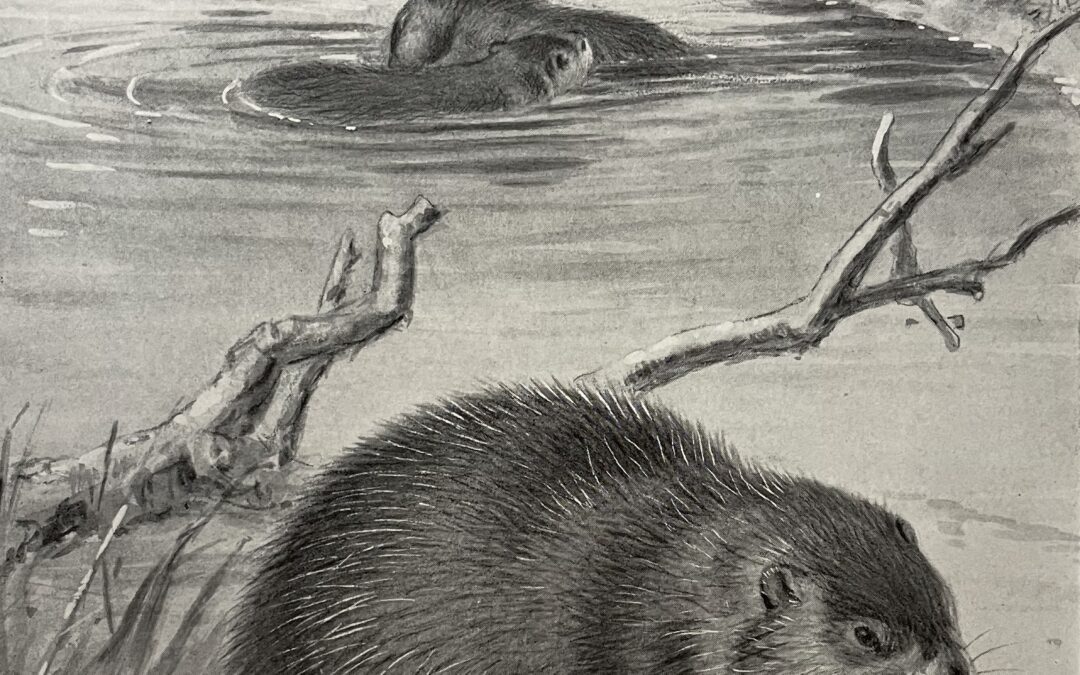Family of Beavers, Ernest Thompson Seton
This is an excerpt from Life-Histories of Northern Animals published in 1910. Seton noted that the beaver has “a massive skull of the general squirrel-type.” While he did not say so, this similarity led biologists to (incorrectly) conjecture the possibility of a close relationship between the two groups (i.e., Beavers are not Squirrels.) A personal observation: Beavers are fun to watch at dusk when they come out to feed and build. Following below are some of Seton’s thoughts about this amazing aquatic rodent.
Castor canadensis (Kuhl). French Canadian: le Castor. Cree: Ah-misk‘. Muskego: Ah-mik-kuk. Ojib.: Ah-mik. Chipewyan: Tsa. Yankton Sioux: Tcha-pa. Ogallala Sioux: Chan-pah’.
Goodbye Beaver
“The average annual total of Beaver skins brought out by the American fur companies and the Hudson’s Bay Company for the period between 1860 and 1870, when the fur trade was at its height, is, in round numbers, 153,000. But the natives used as many good pelts as they sold and seldom saved the skins of those taken in summer, though they killed for food the whole year round. So that 500,000 per annum is more likely to represent the aggregate destruction by man. This was at least doubled by other agencies and the total death rate would reach not less than 1,000,000.
This evidently was more than they could stand, for their numbers steadily dwindled. A creature breeding as fast as a Beaver is supposed to add 20 per cent. per annum to its population, therefore 1,000,000 being somewhat over 20 per cent., would leave us about 5,000,000 as the possible original population. (Pg. 451-452)
The Dam
The dam is the most famous if not the most remarkable of the Beaver’s undertakings. It is a vast structure of sticks, stones and roots, mud and sod laid across a running stream to back up the water, ensure the Beavers depth enough to protect them from their enemies all summer, and preclude all danger of freezing to the bottom in winter. Morgan describes two kinds, the open stick dam, faced with mud on the up-stream side and through the top of which the water trickles all along; and the solid-bank dam which is of earth and has an overflow at one place, where it is reinforced with sticks. I take it that the latter is simply a very old dam in which the sticks have rotted away from the main structure, and which the grass and growing stuff have solidified into a green bank. (Pg. 453)
Felling Trees
The cutting down of trees is one of the most amazing performances of the Beavers, so it has of course been exaggerated in early accounts. Thus the statement that the Beaver is so skillful that it can always throw a tree toward the stream is quite misleading. It cuts first the trees on the margin and they always lean toward the stream, so must fall streamward. But later, when cutting further afield, the trees as often go wrong as right. The work of felling is usually done by the pair with the assistance at times from their grown-up children.
Two Beavers can cut down a three-inch sampling in three minutes and a six-inch tree in an hour or two. Three are the most that have been seen working on the same tree as once.
Many times the tree goes the wrong way. This I have often seen, and frequently it has happened that some Beaver made a miscalculation and was killed by the fall of his own tree.
The largest trunk I have ever seen cut down by Beavers was 14 inches in diameter, a poplar but we have records of cottonwoods 20 and 24 inches, nearly 3 feet. These, however, are exceptional; 3 to 8 inches is the usual run. At one Beaver cutting I counted 116 poplar stumps. There six such places near the dam, but the largest stump of any was but 8 inches through. (Pg. 464-466)
Yellowstone Park
The Beavers near Yancy’s, in Yellowstone Park, have, like most wild things there, realized the blessed peace of the Park. The came out soon after sundown while I watched them from a hide. I saw 4 swimming about the same time. But only the biggest one seemed interested in repairing the dam, and he worked “like a Beaver” the whole time, never passing the dam without adding something, and if he had nothing else would dive to the bottom for a handful of mud, and pound it into the dam wherever he fancied the water was running over. It never seemed to occur to him that the water must go over somewhere; so the work of stopping the supposed leak goes on indefinitely and the dam grows bigger.” (Pg. 472)

